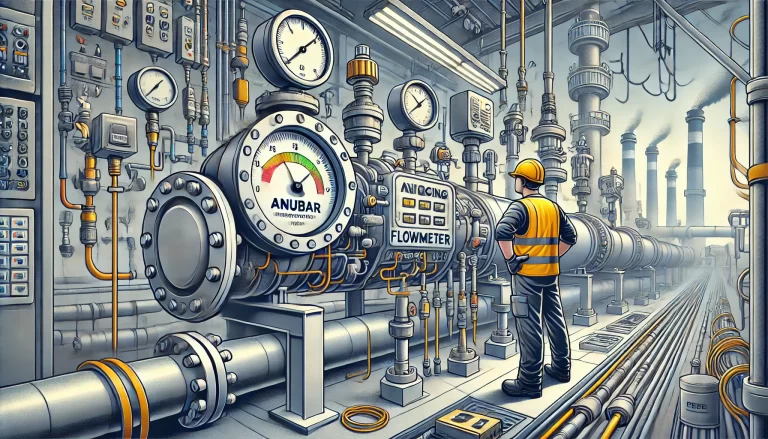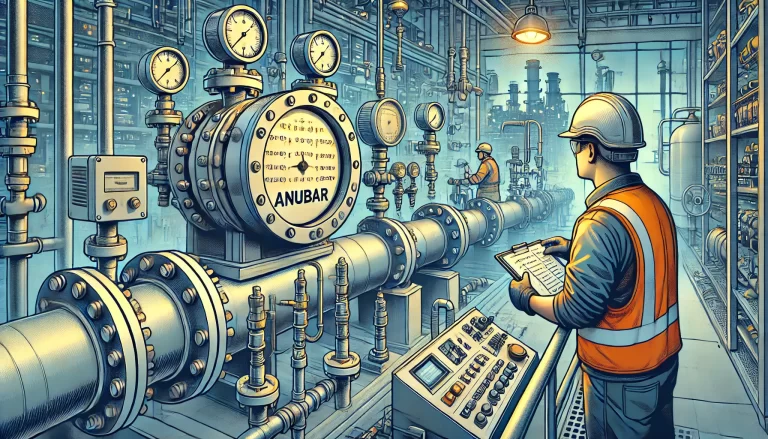1. Introduction to Anubar Flowmeter
An Anubar flowmeter, also known as an averaging Pitot tube flowmeter, is a differential pressure-based instrument widely used to measure fluid flow in pipelines. It operates on the principle of Bernoulli’s equation, which relates pressure differences to fluid velocity. The Anubar flowmeter captures pressure readings at multiple points across the pipe’s cross-section, averages them, and calculates flow rates with high accuracy and reliability.
Due to its simple design, ease of installation, and ability to handle a variety of fluid types (liquid, gas, and steam), the Anubar flowmeter is widely applied in industrial processes such as power generation, oil and gas, and water treatment.

2. Common Faults of Anubar Flowmeter
During the operation of Anubar flowmeters, several types of faults can occur. These faults may affect measurement accuracy, lead to incorrect readings, or cause the device to malfunction entirely. The following are the most common issues:
2.1 Sensor Damage or Connection Issues
Phenomenon:
Sudden loss of signal or no flow data displayed.
Erratic or fluctuating readings.
Cause:
The pressure sensor may be damaged due to physical wear, corrosion, or exposure to harsh chemicals.
Sensor connections may become loose over time due to vibrations or improper installation.
Solution:
Inspect the sensor for physical damage. If damage is detected, replace the sensor with a compatible model.
Ensure sensor connections are tight and secure. Reconnect or recalibrate the sensor if needed.
Perform a signal test to confirm proper communication between the sensor and the transmitter.
2.2 Unstable Power Supply
Phenomenon:
Inaccurate or intermittent readings.
Device fails to power on or resets frequently.
Cause:
Voltage fluctuations or an unstable power supply.
Power cable damage or poor contact at terminals.
Solution:
Use a voltage stabilizer or uninterrupted power supply (UPS) to ensure a steady power input.
Inspect power connections and cables for wear or poor contact, and replace them as necessary.
Verify the power source voltage matches the flowmeter specifications.
2.3 Electromagnetic Interference (EMI)
Phenomenon:
Measurement readings fluctuate significantly or display unrealistic values.
Cause:
Nearby electromagnetic fields from equipment such as motors, inverters, high-voltage cables, or cellular communication towers can interfere with flowmeter signals.
Solution:
Relocate the flowmeter installation to a location farther from EMI sources.
Install shielding or protective enclosures to minimize electromagnetic interference.
Use twisted-pair cables with proper grounding for signal transmission.
2.4 Changes in Fluid Properties
Phenomenon:
Flow readings deviate from expected values.
Measurement errors increase despite a functioning device.
Cause:
Changes in fluid temperature, density, pressure, or viscosity can affect the flowmeter’s calibration and accuracy.
Foreign particles or debris in the fluid can obstruct the pressure ports.
Solution:
Ensure fluid properties (temperature, pressure, density) remain within the operating range specified by the manufacturer.
Install appropriate filters or strainers to remove particles from the flow.
Recalibrate the flowmeter to match current fluid conditions.

3. Maintenance and Troubleshooting Methods
Proper maintenance and timely troubleshooting are critical for the long-term reliability and accuracy of Anubar flowmeters. Below are detailed inspection and repair procedures:
3.1 Sensor Maintenance and Inspection
Visual Inspection:
Check the sensor for physical damage, corrosion, or contamination.
Verify the integrity of sensor ports and pressure taps.
Sensor Replacement:
If damage is irreparable, replace the sensor with a compatible spare part.
After replacement, calibrate the flowmeter to ensure accurate readings.
Connection Checks:
Inspect the wiring connections and terminals for looseness or corrosion.
Reconnect loose cables securely and ensure proper signal transmission.
3.2 Power System Troubleshooting
Power Supply Verification:
Use a multimeter to measure input voltage and ensure it remains stable within the required range.
Cable and Terminal Check:
Inspect power cables for damage or wear.
Tighten terminals and ensure clean, corrosion-free contact points.
Stabilization Measures:
Install a voltage regulator or UPS to avoid power fluctuations.
3.3 Addressing Electromagnetic Interference
Relocation:
If feasible, relocate the flowmeter away from high EMI sources.
Shielding Installation:
Install metal shielding or enclosures around the sensor and signal cables.
Cable Management:
Use twisted-pair shielded cables for signal transmission.
Properly ground all shielding to minimize interference.
3.4 Fluid Property Adjustments
Fluid Condition Monitoring:
Periodically test fluid density, temperature, and pressure to confirm they remain within specifications.
Filtration:
Install inline filters or strainers to remove debris and prevent clogging.
Recalibration:
Recalibrate the flowmeter after significant changes in fluid properties to maintain accuracy.

4. Preventative Maintenance Measures
To minimize faults and extend the lifespan of Anubar flowmeters, the following preventative maintenance practices should be implemented:
Regular Inspections:
Perform monthly inspections of sensors, power connections, and signal outputs.
Calibration Checks:
Conduct routine recalibration every 6-12 months based on usage and environmental conditions.
EMI Mitigation:
Design installation layouts that avoid proximity to strong EMI sources.
Power Stability:
Use dedicated power circuits and surge protectors for flowmeter installations.
Fluid Quality Management:
Monitor and maintain fluid cleanliness using filters to prevent obstruction or corrosion of sensor ports.

5. Conclusion
The Anubar flowmeter is a robust and reliable tool for flow measurement in industrial processes. However, faults such as sensor damage, power instability, electromagnetic interference, and changes in fluid properties can impact its performance. By implementing systematic troubleshooting and maintenance practices, these issues can be effectively resolved, ensuring accurate and efficient operation.
Regular inspections, proper installation, and preventative maintenance are key to minimizing downtime and maximizing the flowmeter’s lifespan. With these measures in place, Anubar flowmeters can continue to deliver precise flow measurements and contribute to process optimization in various industries.
